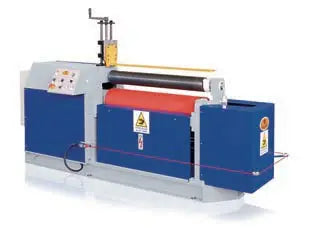What are metal plate rolls?
The metal plate rolling machine is a type of equipment that uses work rolls to bend metal sheets, allowing cylindrical, conical and other shaped pieces to be formed.
It is a crucial equipment in sheet metal manufacturing.
Types of metal plate rolls
Rolling mills are essential production equipment used in various industries, including household appliances, pressure vessels, wind energy, shipping, aerospace, military, and automobile refurbishment.
The sheet metal rolling machine has the ability to bend sheet metal into large arcs, cylinders, ellipses, squares and multi-sectional arcs.
In this article, we will provide a brief overview of sheet metal roller types and applications.
Two Roll Plate Bending Machine
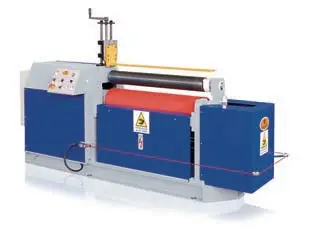
The double roll sheet metal bending machine has an upper roller made of rigid metal and a lower roller covered with high-strength polyurethane material that can be adjusted vertically.
When the roller rotates, the upper roller and feed plate are subjected to pressure, causing the elastic layer of the lower roller to deform. The constant volume of the elastomer results in uniform, continuous back pressure that forces the plate and rigid roller to remain in close contact, allowing the plate to be formed into a cylinder through rotation.
The depth of deformation of the elastic layer, or recoil of the upper roller, is the main technological parameter that determines the radius of curvature. Studies have shown that as the reduction increases, the radius of curvature of the sheet metal decreases, but once a certain indentation value is reached, the radius of curvature tends to remain stable regardless of the reduction. This is an important feature of double roller plate bending technology.
Double roll plate bending machines are mainly designed for metal plates with a width of 2000mm and a thickness of less than 2mm for round rolling, making them ideal for batch production of thin containers in the home appliance industry. These machines often come equipped with automatic feeding and unloading systems, offering high levels of automation and greater efficiency.
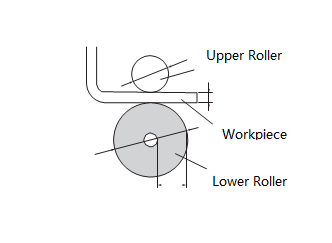
Benefits:
The advantages of double roll sheet metal bending machine include:
- There is no need to bend the ends, resulting in fast processing speed.
- Able to achieve high precision modeling in a single stroke.
- Metal plates do not crack or warp irregularly, even after punching, cutting and rolling.
- Does not cause wrinkles or scratches on the surface of the pieces.
- Increasing the rolling reduction or changing the spacing of the two rolls does not affect the diameter of the parts, making it easy to use and less demanding in terms of precision.
Disadvantages:
However, the double roll sheet metal bending machine has some limitations, including:
- The need to change the guide roller wheel for each change in part diameter makes it unsuitable for multiple variety and small batch production.
- It is not capable of processing thick sheets, with a maximum sheet thickness of 6 to 9mm.
Three Roll Plate Rolling Machine
There are several types of three-roll plate bending machines, which can be classified into mechanical and hydraulic categories.
From the structural point of view, three-roll plate bending machines can be divided into three-roll inclined plate rolling machines, under-roll horizontal movement type and geometric variable type.
3-roll asymmetric bending machine
Asymmetric 3-roll bending machines are typically powered by a mechanical motor. The upper and lower rollers are both fixed motorized rollers, with the upper roller being stationary and the lower roller capable of lifting and rotating. The lower roller works together with the upper roller to press the front end of the metal plate, while the side roller, serving as an auxiliary roller, lifts to deform the plate during bending. The upper and lower rollers work together to achieve round and arc rolling of the metal plate.
These machines are used to roll low carbon steel plates with lengths less than 2,500 mm and thicknesses less than 4 mm into cylinders or arc segments. The lamination process is fast and efficient, saving energy and reducing production costs.
However, the pre-curved linear segment is twice the thickness of the plate and the machine requires skilled operators, increasing technical personnel requirements.
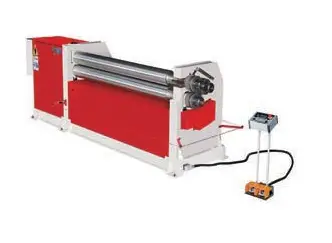
Lower roller horizontal movement type
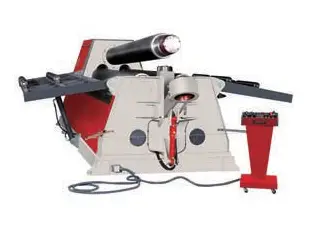
Bottom Roll Horizontal Movement 3-roll plate rollers are the most widely used and well-established plate rolling machines both nationally and internationally. They are typically powered by hydraulic drive.
The working principle of bottom roller horizontal movement with 3 roller plate rollers is as follows:
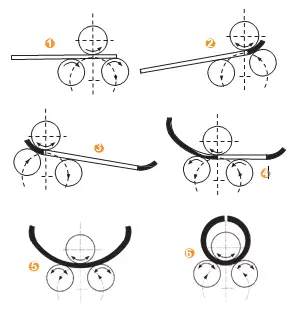
The upper roller is a fixed and motorized rotating roller, and the two side rollers move along a predetermined arc track during operation to press the metal plate together with the upper roller. Rotation of the upper roller completes the cylinder or cone rolling process.
Type 3 roll plate bending machines with horizontal bottom roll movement can typically roll plates with a width of up to 4000mm and a thickness of 6-40mm. The main advantage of these machines is their relatively low cost. However, they require highly skilled operators as the forming process cannot be completed in a single pass and the pre-curved linear segment is greater than twice the thickness of the plate.
Variable geometric plate laminating machine
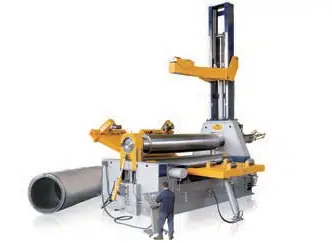
Variable geometric sheet rolling mills are the most advanced sheet rolling equipment available both domestically and internationally. They are capable of rolling metal plates with thicknesses ranging from 20 to 250 mm.
The working principle of variable geometric plate rolling mills is shown in the following image.
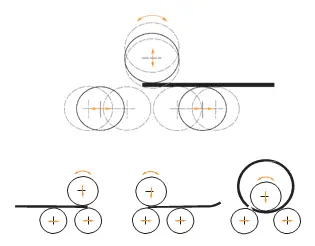
In a variable geometric plate rolling mill, the top roll is a motorized roll that can move up and down, while the two side rolls serve as driving rolls that can move horizontally independently.
The movement of each roll can create a specific geometric shape, giving rise to the name “variable geometric sheet rolling machine”.
During operation, the machine employs horizontal plate feeding and pre-bending, eliminating the need for side thrust devices and outward side roller movement. Furthermore, the bending capacity increases significantly and the pre-curved linear segment is no greater than the thickness of the plate.
Advantage:
The variable geometric sheet rolling mill offers several advantages, including:
- The ability to replace the upper roller with rollers of different diameters.
- Option to install a numerical control system with PLC, reducing the skill level required from the operator.
- The absence of a significant pre-curved linear segment.
- Horizontal feed, eliminating the need for an expensive side thrust device.
- Ability to roll large angle tapered parts.
- A lower price compared to four roller plate bending machines with similar bending capabilities.
Disadvantage:
However, the variable geometric sheet rolling mill has some limitations, including:
- Slower rolling speed compared to four-roll bending machines.
- Inability to scroll multi-segmented arc shapes.
Four Roller Plate Laminating Machine
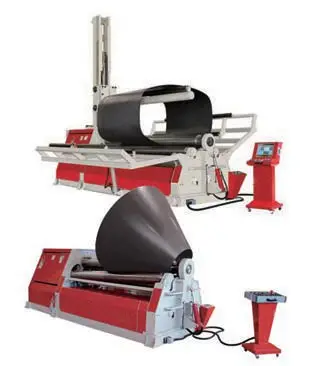
Four roll bending machines are highly reliable and widely used in the manufacturing industry. They are versatile machines, capable of rolling multi-segmented arc shapes, O-shapes, squares, circles, arcs and much more. These machines can also be equipped with a highly automated CNC man-machine dialogue system.
Four-roll bending machines come in mechanical and hydraulic varieties, with the mechanical type suitable for rolling metal plates less than 6mm thick and the hydraulic type capable of rolling plates up to 6-200mm thick.
The following image demonstrates the working principle of a 4-roll sheet metal bending machine.
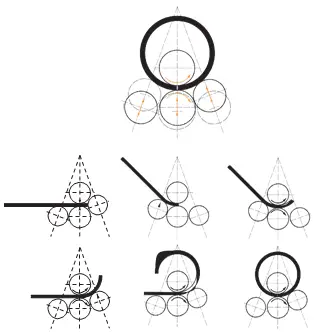
The upper roller on a 4-roll sheet metal bending machine is a motorized rotating roller that is fixed in place, while the lower roller can move up and down. The lower roller works together with the upper roller to secure the metal plate. The two side rollers move up and down in an oblique direction, serving to position and form the plate.
Although the working principle of 4-roll plate bending machines is consistent across the market, there are structural differences such as the use of planetary arc guides or linear guides for lateral movement of the rolls.
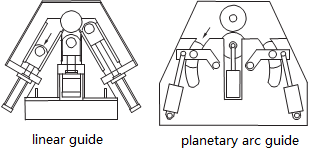
Before 2003, 4-roll plate bending machines mainly used linear guides. Since then, planetary arc guides have become the dominant technology.
Some manufacturers still choose to use linear guides, despite the higher cost, as they are easier to maintain. Linear guides also offer significant advantages when rolling high-alloy or titanium alloy plates.
For metal plates with yield strengths less than 500Mpa, the difference between linear and planetary arc guides is minimal. Planetary arc guides offer a much lower cost of use.
Advantage:
Four-roll bending machines are capable of satisfying the full range of sheet metal rolling requirements and can be equipped with high levels of automation, including automatic up-feed and down-feed devices.
Disadvantage:
However, the pre-curved linear segment is greater than 1.5 times the thickness of the plate.
In addition to the common plate rollers mentioned above, specialized rollers such as vertical rollers, reinforced drum rollers, and ship rollers, among others, are also available.

